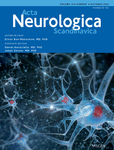Characteristics and outcome in an Egyptian Cohort with status epilepticus
Abstract
Objectives
Status epilepticus (SE) is an important cause of mortality worldwide. Information regarding associations of mortality outcome in Egypt is limited. The main objective of this study was to describe the clinical characteristics and factors associated with mortality of patients with SE admitted to Cairo University Hospitals.
Methods
A prospective observational hospital-based study was conducted from January 2017 to June 2018. Patients with SE aged ≥12 years old were followed with documentation of outcome on discharge as survival versus death.
Results
The study cohort included 144 SE patients. The majority of episodes (96.5%) were with prominent motor features, while nonconvulsive SE occurred in 3.5%. There was a clear semiology evolution in 22.9% of episodes, 56.3% had unchanging semiology (e.g., just convulsive or just nonconvulsive) and the semiology evolution could not be discerned in 20.8%. In relation to treatment, the majority of cases were responsive (46.5%), whereas 43.1% were refractory and only 10.4% were super-refractory SE. Apart from seven patients who were referred to other hospitals, 99 patients survived whereas 38 (26.4%) died. After regression analysis, only absence of a history of epilepsy, semiology evolution and mechanical ventilator use were associated with mortality increasing its odds by 3.7, 5, 111 times, respectively.
Conclusion
Absence of a history of epilepsy, SE semiology evolution, and mechanical ventilator use was found to be associated with mortality outcome among Egyptian patients with SE.
CONFLICTS OF INTEREST
None of the authors has any conflict of interest to disclose.
Open Research
DATA AVAILABILITY STATEMENT
The datasets used and/ or analyzed during the current study are available from the corresponding author on reasonable request with permission of Faculty of Medicine, Cairo University, Egypt.




